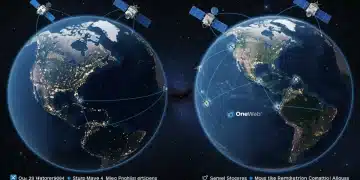FCC Broadband Mapping: Access 2025 Subsidies Now

US residents can now leverage the new FCC Broadband Mapping to access critical 2025 subsidies, ensuring enhanced connectivity and bridging the digital divide nationwide.
As of late 2024, significant updates to the FCC Broadband Mapping system are directly impacting how US residents can access crucial 2025 subsidies for internet services. This guide provides practical solutions to help you understand and utilize these changes effectively.
Understanding the New FCC Broadband Map Data
The Federal Communications Commission (FCC) has recently unveiled its updated National Broadband Map, a critical tool for identifying areas lacking adequate internet access. This map is not just a visual representation; it’s the foundation for allocating billions in federal funding through programs like the Broadband Equity, Access, and Deployment (BEAD) Program and the Affordable Connectivity Program (ACP). Understanding its intricacies is the first step for any US resident seeking to benefit from upcoming subsidies.
The map’s accuracy is paramount, as it dictates where federal funds will be directed. Initial data collection has faced scrutiny, leading to ongoing efforts by the FCC to refine its information. Residents are now empowered to directly influence this data, ensuring their specific broadband situation is correctly represented. This direct citizen involvement is a new, crucial component of the FCC’s strategy to close the digital divide.
The Importance of Accurate Data
Accurate data on broadband availability and speed directly correlates with subsidy eligibility. Inaccurate reporting can lead to areas being overlooked for funding, perpetuating connectivity gaps. The FCC’s system relies heavily on self-reported data from internet service providers (ISPs), which has historically presented challenges regarding precision.
- Funding Allocation: Subsidies are allocated based on identified unserved and underserved areas.
- Program Eligibility: Individual and community eligibility for programs like BEAD and ACP depends on reported service levels.
- Infrastructure Development: Future broadband infrastructure projects are planned according to the map’s depiction of needs.
How to Check Your Broadband Service on the Map
For US residents, verifying their current broadband service status on the FCC map is a critical initial step. The process is designed to be user-friendly, allowing individuals to quickly ascertain what the FCC believes their address has in terms of internet availability. This direct interaction is vital, especially given the historical discrepancies in reported data versus actual service. The map provides a snapshot of reported coverage from various ISPs, including speeds and technologies available.
Accessing the map is straightforward. Users simply navigate to the FCC’s dedicated broadband map website and input their residential address. The system then displays a detailed overview of reported internet services at that specific location. It’s important to review not just the availability, but also the advertised download and upload speeds, and the type of technology used (fiber, cable, DSL, satellite, fixed wireless).
Step-by-Step Verification Process
Checking your service involves a few key steps to ensure you gather all necessary information. Pay close attention to provider names and reported service tiers.
- Visit the Official FCC Broadband Map: Ensure you are on the legitimate FCC website to avoid misinformation.
- Enter Your Address: Input your full residential address, including zip code, for precise results.
- Review Reported Services: Examine the list of providers and the speeds they claim to offer at your location.
- Compare with Actual Service: Cross-reference the map’s data with your actual internet service experience.
Challenging Inaccurate FCC Broadband Map Data
One of the most empowering features of the new FCC Broadband Mapping system is the ability for US residents to directly challenge inaccurate data. This mechanism is crucial for ensuring that federal subsidies are directed to the areas that genuinely need them. If the map incorrectly shows your address as served by a broadband provider, or at speeds you do not actually receive, you have the right and responsibility to submit a challenge. This direct feedback loop is integral to improving the accuracy of the national map and, consequently, the equitable distribution of broadband funding.
The process for submitting a challenge is designed to be accessible, though it requires attention to detail. It involves providing specific information about your service, or lack thereof, to counter the data reported by ISPs. Your challenge can pertain to availability, speed, or even latency issues that render the service unusable for modern demands. Every challenge contributes to a more accurate national picture of broadband access.

Submitting a Location Challenge
A location challenge is appropriate if the map indicates service at your address that simply isn’t available. This could be due to outdated information or incorrect reporting by an ISP.
- Gather Evidence: Collect screenshots of the map, service denial letters, or communication from ISPs stating they cannot serve your location.
- Initiate the Challenge: On the FCC map portal, select the option to challenge data for your address.
- Provide Details: Clearly explain why the map’s data is incorrect, referencing your evidence.
Similarly, a service challenge focuses on discrepancies in reported speeds or service quality. If the map claims you have access to high-speed fiber but you only receive slow DSL, a service challenge is necessary. This type of challenge helps to highlight areas that are technically ‘served’ but not ‘served adequately’ for current digital needs. It’s a vital distinction for securing future funding.
Accessing 2025 Broadband Subsidies: Key Programs
With the FCC Broadband Mapping data being refined, focus now shifts to accessing the 2025 broadband subsidies. These federal programs are designed to make internet access more affordable and widespread, particularly in unserved and underserved communities. Understanding the key programs available and their eligibility criteria is essential for US residents looking to reduce their monthly internet costs or gain access to reliable service for the first time. The primary programs include the Affordable Connectivity Program (ACP) and the Broadband Equity, Access, and Deployment (BEAD) Program.
The ACP provides a monthly discount on internet service for eligible low-income households, directly addressing affordability barriers. The BEAD Program, on the other hand, is a larger infrastructure initiative, allocating funds to states to expand broadband access in areas currently lacking it. While BEAD funds are distributed at the state level, residents’ challenges on the FCC map directly impact where these state funds are ultimately deployed, making citizen participation doubly important.
The Affordable Connectivity Program (ACP)
The ACP is a direct consumer benefit, offering significant savings on internet bills. Eligibility is broad, covering various income levels and participation in other federal programs.
- Monthly Discount: Up to $30/month off internet service, or up to $75/month for households on Tribal lands.
- One-time Device Discount: Up to $100 off a laptop, desktop computer, or tablet through a participating provider.
- Eligibility Criteria: Includes participation in SNAP, Medicaid, SSI, Federal Public Housing Assistance, or having an income at or below 200% of the federal poverty guidelines.
The BEAD Program, administered by the National Telecommunications and Information Administration (NTIA), aims to build robust, future-proof broadband infrastructure. States are currently developing their five-year action plans, which will detail how they intend to use their BEAD allocations. Your participation in map challenges directly influences these state plans.
The Role of States and Local Governments in Broadband Expansion
While the FCC sets the national framework and the NTIA administers key funding, states and local governments play a crucial role in the last-mile delivery of broadband expansion and subsidy programs. Each state receives a specific allocation under the BEAD Program, which they then must strategize to deploy effectively. This involves creating detailed five-year plans, identifying priority areas, and partnering with internet service providers to build out infrastructure. For US residents, understanding these local dynamics is vital for both advocating for better service and accessing available support.
Local governments, including counties and municipalities, are often the direct points of contact for residents regarding broadband issues. They can initiate local projects, secure matching funds, and assist residents in navigating the application processes for subsidies like the ACP. Many states have also established their own broadband offices or task forces to coordinate efforts and ensure equitable access across their jurisdictions. These entities are key for translating federal initiatives into tangible community benefits.
State Broadband Offices and Initiatives
Most states now have dedicated offices or programs focused on improving broadband access. These offices serve as resources for both residents and local entities.
- Coordination: States coordinate federal and state funding to maximize impact.
- Local Partnerships: They often work with local governments and community organizations to identify needs.
- Public Engagement: Many state offices conduct public outreach to gather feedback and inform residents.
Residents should actively engage with their state and local broadband initiatives. Attending town halls, participating in surveys, and communicating directly with local officials can significantly influence where and how broadband improvements are implemented. These local efforts often complement the federal FCC Broadband Mapping data, providing granular insights that can accelerate project deployment.
Tips for Maximizing Your Connectivity Benefits
To fully leverage the opportunities presented by the updated FCC Broadband Mapping and upcoming 2025 subsidies, US residents must adopt a proactive approach. Maximizing your connectivity benefits goes beyond simply checking a box; it involves staying informed, engaging with relevant authorities, and making strategic choices about your internet service. The landscape of broadband access and affordability is evolving rapidly, and those who actively participate in the process are best positioned to reap the rewards.
This proactive stance includes regularly reviewing the FCC map, understanding your eligibility for various programs, and not hesitating to challenge inaccuracies. Additionally, exploring local resources and understanding the nuances of different internet service plans can lead to significant savings and improved service quality. The goal is not just to get connected, but to get connected efficiently and affordably, ensuring that broadband truly serves as a utility for all.
Key Strategies for Residents
A multi-faceted approach will yield the best results in securing and maintaining affordable, reliable internet service. Consider these practical tips:
- Regularly Check the FCC Map: Broadband data is dynamic, and updates can affect your area’s status.
- Verify ACP Eligibility: Re-check eligibility for the Affordable Connectivity Program as circumstances or program rules may change.
- Engage with Local Initiatives: Participate in local broadband planning meetings or surveys to voice your community’s needs.
Furthermore, compare different internet service providers in your area. Even if you’re eligible for subsidies, price and service quality can vary significantly. Look for providers that offer plans specifically designed to work with ACP benefits, potentially leading to free or extremely low-cost internet. Don’t underestimate the power of community organizing; collective action can draw attention to local broadband disparities and spur action from providers and policymakers.
| Key Point | Brief Description |
|---|---|
| FCC Map Accuracy | The new FCC map is crucial for 2025 subsidy allocation; residents must verify data for their address. |
| Challenging Data | Residents can challenge incorrect map data regarding service availability or speed directly through the FCC portal. |
| Accessing Subsidies | Key programs like ACP and BEAD offer financial aid for internet service and infrastructure expansion. |
| Local Engagement | Engaging with state and local broadband initiatives is vital for advocating for community needs and project deployment. |
Frequently Asked Questions About FCC Broadband Mapping and Subsidies
The FCC Broadband Map aims to accurately identify areas in the US that lack adequate internet service. This precise data is crucial for allocating federal funds, like those from the BEAD Program, to expand broadband infrastructure and ensure equitable access nationwide.
You can challenge inaccurate data by visiting the official FCC Broadband Map website and entering your address. If the map incorrectly shows service availability or speed, you can submit a location or service challenge with supporting evidence directly through the portal.
Eligibility for the ACP includes households participating in federal assistance programs (e.g., SNAP, Medicaid, SSI) or those with incomes at or below 200% of the federal poverty guidelines. Qualified households receive a monthly discount on internet service.
The Broadband Equity, Access, and Deployment (BEAD) Program allocates billions to states to build new broadband infrastructure in unserved and underserved areas. This program aims to bring high-speed internet to communities that currently lack reliable access, fostering economic development and digital inclusion.
While the FCC continuously updates its map, challenges submitted promptly are crucial. States are finalizing their BEAD plans based on the current data, so early challenges ensure your area’s needs are reflected ahead of 2025 funding allocations. Check the FCC website for specific deadlines.
Looking Ahead: The Future of US Broadband Access
The ongoing refinement of the FCC Broadband Mapping and the distribution of 2025 subsidies mark a pivotal moment for internet access in the United States. The emphasis on accurate data and direct resident engagement signifies a crucial shift towards a more equitable digital landscape. What happens next will largely depend on sustained public participation and the effective implementation of state-level broadband plans. We anticipate a period of significant infrastructure development and increased affordability, but vigilance from residents will remain essential to ensure promises translate into tangible improvements on the ground. The goal is ubiquitous, affordable connectivity for all, and the current efforts are laying the groundwork for that future.





